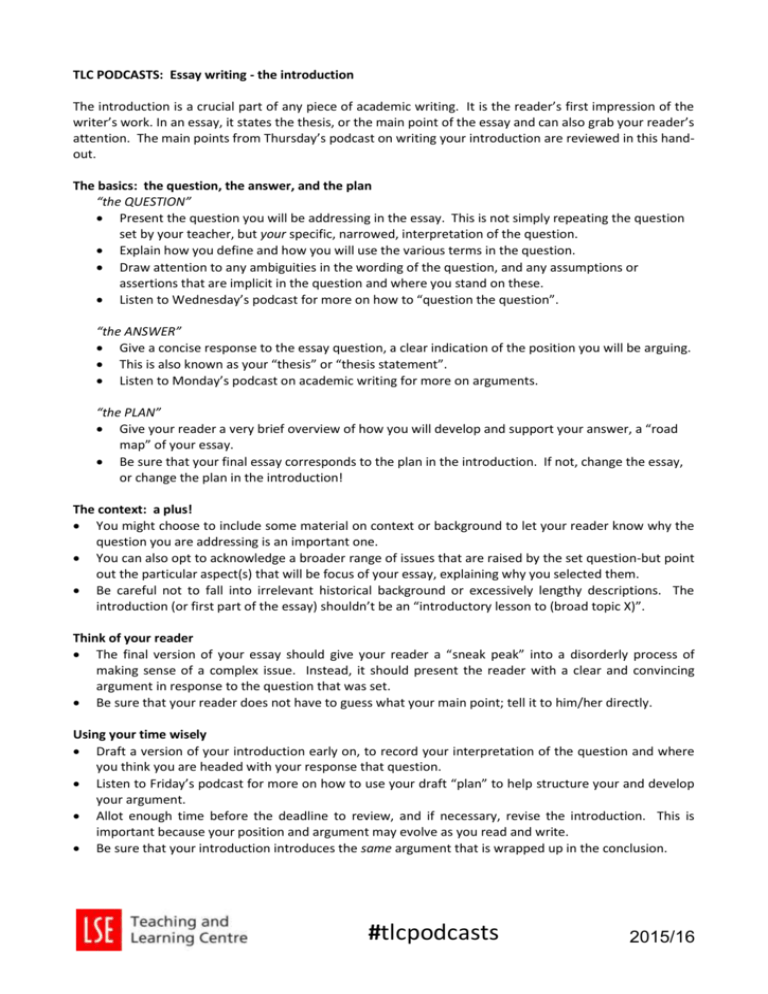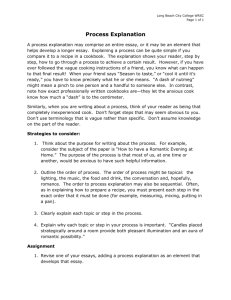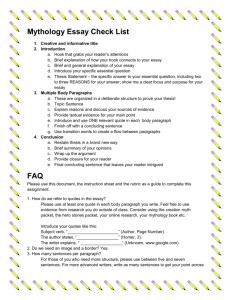Episode 005 - Key points
advertisement

TLC PODCASTS: Essay writing - the introduction The introduction is a crucial part of any piece of academic writing. It is the reader’s first impression of the writer’s work. In an essay, it states the thesis, or the main point of the essay and can also grab your reader’s attention. The main points from Thursday’s podcast on writing your introduction are reviewed in this handout. The basics: the question, the answer, and the plan “the QUESTION” Present the question you will be addressing in the essay. This is not simply repeating the question set by your teacher, but your specific, narrowed, interpretation of the question. Explain how you define and how you will use the various terms in the question. Draw attention to any ambiguities in the wording of the question, and any assumptions or assertions that are implicit in the question and where you stand on these. Listen to Wednesday’s podcast for more on how to “question the question”. “the ANSWER” Give a concise response to the essay question, a clear indication of the position you will be arguing. This is also known as your “thesis” or “thesis statement”. Listen to Monday’s podcast on academic writing for more on arguments. “the PLAN” Give your reader a very brief overview of how you will develop and support your answer, a “road map” of your essay. Be sure that your final essay corresponds to the plan in the introduction. If not, change the essay, or change the plan in the introduction! The context: a plus! You might choose to include some material on context or background to let your reader know why the question you are addressing is an important one. You can also opt to acknowledge a broader range of issues that are raised by the set question-but point out the particular aspect(s) that will be focus of your essay, explaining why you selected them. Be careful not to fall into irrelevant historical background or excessively lengthy descriptions. The introduction (or first part of the essay) shouldn’t be an “introductory lesson to (broad topic X)”. Think of your reader The final version of your essay should give your reader a “sneak peak” into a disorderly process of making sense of a complex issue. Instead, it should present the reader with a clear and convincing argument in response to the question that was set. Be sure that your reader does not have to guess what your main point; tell it to him/her directly. Using your time wisely Draft a version of your introduction early on, to record your interpretation of the question and where you think you are headed with your response that question. Listen to Friday’s podcast for more on how to use your draft “plan” to help structure your and develop your argument. Allot enough time before the deadline to review, and if necessary, revise the introduction. This is important because your position and argument may evolve as you read and write. Be sure that your introduction introduces the same argument that is wrapped up in the conclusion. #tlcpodcasts 2015/16









